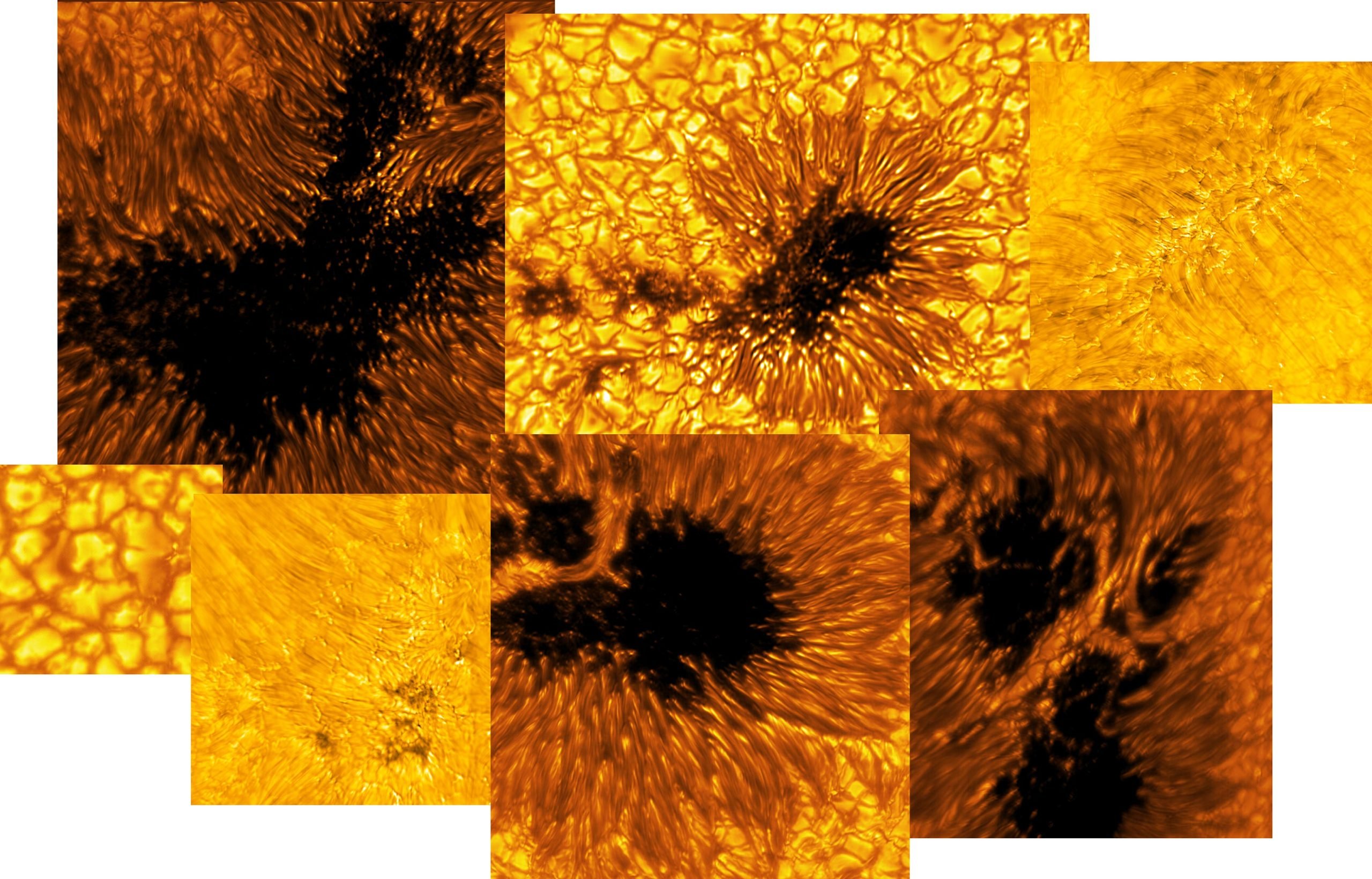Primeros planos increíblemente detallados del Sol desde el telescopio solar más poderoso de la Tierra

Se ha publicado un mosaico de nuevas imágenes solares producidas por el Telescopio Solar Inouye, que visualiza los datos solares obtenidos durante el primer año de funcionamiento del telescopio durante su fase de puesta en marcha. Las imágenes incluyen manchas solares y elementos solares tranquilos. Crédito: NSF/AURA/NSO
La visualización de los primeros datos del Telescopio Solar Inouye tomados durante su ventana de observación del Ciclo 1 muestra las manchas solares y las regiones tranquilas del Sol.
El Telescopio Solar Inouye de NSF ha publicado nuevas imágenes de alta resolución del Sol, que muestran manchas solares y regiones tranquilas. Las imágenes, tomadas durante la ventana de operaciones de 2022 del Ciclo 1, destacan la capacidad del telescopio para capturar detalles solares sin precedentes, lo que ayuda a los científicos a comprender el campo magnético del Sol y las tormentas solares.
El Telescopio Solar Daniel K. Inouye de la Fundación Nacional de Ciencias (NSF) ha publicado ocho nuevas imágenes del Sol, que muestran la emocionante ciencia en curso en el telescopio solar terrestre más poderoso del mundo. Las imágenes presentan una variedad de manchas solares y regiones silenciosas en el Sol tomadas por el Visible-Broadband Imager (VBI), uno de los instrumentos de primera generación del telescopio.
La capacidad única del Telescopio Solar Inouye para capturar datos con un detalle sin precedentes ayudará a los científicos solares a comprender mejor el campo magnético del Sol y los factores detrás de las tormentas solares.

La atmósfera inferior (cromosfera) del Sol existe por encima de la superficie del Sol (fotosfera). En esta imagen, se ven hebras delgadas y oscuras (fibrillas) en la cromosfera que emanan de fuentes en la fotosfera, en particular, los poros oscuros/fragmentos umbrales y su fina estructura. Un poro es una concentración de campo magnético donde no se cumplen las condiciones para formar una penumbra. Los poros son esencialmente manchas solares que no han tenido o nunca tendrán una penumbra. Penumbra: La región circundante más brillante de una mancha solar umbra caracterizada por estructuras filamentosas brillantes. Título de la imagen: Poros/fragmentos umbrales, fibrillas y otras estructuras finas en la atmósfera y la superficie del Sol PID: PID_1_16 Amplio campo de visión: 30 720 km x 30 720 km. Crédito: NSF/AURA/NSO Procesamiento de imágenes: Friedrich Wöger (NSO), Catherine Fischer (NSO) Crédito científico: Juan Martínez-Sykora (Bay Area Environmental Research Institute)

En esta imagen se ejemplifica la naturaleza fibrilar de la atmósfera solar. Las hebras delgadas y oscuras (fibrillas) son omnipresentes en la cromosfera. El contorno de estructuras brillantes es la firma de la presencia de campos magnéticos en la fotosfera de abajo. Esta imagen fue capturada por el Telescopio Solar Inouye durante una campaña de observación coordinada con Parker Solar Probe de la NASA y Solar Orbiter de la ESA. Crédito: NSF/AURA/NSO
Las manchas solares representadas son regiones oscuras y frías en la “superficie” del Sol, conocida como la fotosfera, donde persisten fuertes campos magnéticos. Las manchas solares varían en tamaño, pero muchas son del tamaño de la Tierra, si no más grandes. Las manchas solares complejas o grupos de manchas solares pueden ser la fuente de eventos explosivos como erupciones y eyecciones de masa coronal que generan tormentas solares. Estos fenómenos energéticos y eruptivos influyen en la capa atmosférica más externa del Sol, la heliosfera, con el potencial de impactar la Tierra y nuestra infraestructura crítica.

En esta imagen se ve la fina estructura del Sol quieto en su superficie o fotosfera. El plasma de calentamiento se eleva en las “burbujas” convectivas brillantes (gránulos) y luego se enfría y cae en las bandas intergranulares oscuras. Dentro de estas bandas intergranulares se observan estructuras brillantes que indican las manifestaciones o firmas del campo magnético. El Telescopio Solar Inouye ayuda a detectar estos “diminutos” elementos magnéticos con gran detalle. Título de la imagen: Gránulos solares, bandas intergranulares y elementos magnéticos del sol en calma PID: PID_1_49 Gran campo de visión: 30.720 km x 30.720 km. Crédito: NSF/AURA/NSO Procesamiento de imágenes: Friedrich Wöger (NSO), Catherine Fischer (NSO)

Una mancha solar es identificable por su umbra central oscura y la penumbra de estructura filamentosa que la rodea. Una mirada más cercana revela la presencia de fragmentos de umbral cercanos, esencialmente una mancha solar que ha perdido su penumbra. Estos fragmentos eran parte de la mancha solar vecina, lo que sugiere que esta puede ser la “fase final” de la evolución de las manchas solares. Aunque esta imagen muestra la presencia de fragmentos de umbral, es extraordinariamente raro captar el proceso de formación o descomposición de una penumbra. Umbra: Región central oscura de una mancha solar donde el campo magnético es más fuerte. Penumbra: La región circundante más brillante de una mancha solar umbra caracterizada por estructuras filamentosas brillantes. Título de la imagen: fragmentos umbral sugieren la “fase final” de una mancha solar PID: PID_1_22 Campo de visión grande: 30 720 km x 30 720 km. Crédito: NSF/AURA/NSO Procesamiento de imágenes: Friedrich Wöger(NSO), Catherine Fischer (NSO) Crédito científico: Jaime de la Cruz Rodríguez (Universidad de Estocolmo)
En las regiones tranquilas del Sol, las imágenes muestran células de convección en la fotosfera que muestran un patrón de calor brillante que fluye hacia arriba.[{” attribute=””>plasma (granules) surrounded by darker lanes of cooler, down-flowing solar plasma. In the atmospheric layer above the photosphere, called the chromosphere, we see dark, elongated fibrils originating from locations of small-scale magnetic field accumulations.

A light bridge is seen crossing a sunspot’s umbra from one end of the penumbra to the other. Light bridges are believed to be the signature of the start of a decaying sunspot, which will eventually break apart. Light bridges are very complex, taking different forms and phases. It is unknown how deep these structures form. This image shows one example of a light bridge in remarkable detail. Umbra: Dark, central region of a sunspot where the magnetic field is strongest. Penumbra: The brighter, surrounding region of a sunspot’s umbra characterized by bright filamentary structures. Image Title: A Light Bridge Captured in a Sunspot PID: PID_1_50 Large Field of View: 30,720km x 30,720km. Credit: NSF/AURA/NSO Image Processing: Friedrich Wöger(NSO), Catherine Fischer (NSO) Science Credit: Tetsu Anan (NSO)

A detailed example of a light bridge crossing a sunspot’s umbra. In this picture, the presence of convection cells surrounding the sunspot is also evident. Hot solar material (plasma) rises in the bright centers of these surrounding “cells,” cools off, and then sinks below the surface in dark lanes in a process known as convection. The detailed image shows complex light bridge and convection cell structures on the Sun’s surface or photosphere. Light bridge: A bright solar feature that spans across an umbra from one penumbra to the other. It is a complex structure, taking different forms and phases, and is believed to be the signature of the start of a decaying sunspot. Umbra: Dark, central region of a sunspot where the magnetic field is strongest. Image Title: Properties of Convection Cells and Light Bridge Seen Around a Sunspot PID: PID_1_29 Large Field of View: 30,720km x 30,720km. Credit: NSF/AURA/NSO Image Processing: Friedrich Wöger(NSO), Catherine Fischer (NSO) Science Credit: Philip Lindner at Leibniz-Institut für Sonnenphysik (KIS)
The recently inaugurated telescope is in its Operations Commissioning Phase (OCP), a learning and transitioning period during which the observatory is slowly brought up to its full operational capabilities.
The international science community was invited to participate in this phase through an Operations Commissioning Phase Proposal Call. In response to these calls, investigators submitted science proposals requesting telescope time for a specific and detailed science goal. In order to optimize for science return, while balancing the available observing time and the technical needs in this very early operational phase, the proposals were subsequently peer-reviewed by a proposal review committee and telescope time was granted by a Telescope Allocation Committee. The selected proposals were executed in 2022 during the Cycle 1 operations window.

This image reveals the fine structures of a sunspot in the photosphere. Within the dark, central area of the sunspot’s umbra, small-scale bright dots, known as umbral dots, are seen. The elongated structures surrounding the umbra are visible as bright-headed strands known as penumbral filaments. Umbra: Dark, central region of a sunspot where the magnetic field is strongest. Penumbra: The brighter, surrounding region of a sunspot’s umbra characterized by bright filamentary structures. Image Title: Sunspot Umbral Dots and Penumbral Filaments in Detail PID: PID_1_27 Large Field of View: 30,720km x 30,720km. Credit: NSF/AURA/NSO Image Processing: Friedrich Wöger(NSO), Catherine Fischer (NSO) Science Credit: Rolf Schlichenmaier at Leibniz-Institut für Sonnenphysik (KIS)

This image, taken by Inouye Solar Telescope in coordination with the ESA’s Solar Orbiter, reveals the fibrillar nature of the solar atmosphere. In the atmosphere, or chromosphere, fine, dark threads of plasma (fibril) are visible emanating from the magnetic network below. The outline of bright structures are signature of the presence of magnetic fields. Image Title: The Fibrillar Nature of the Solar Atmosphere PID: PID_1_123 Large Field of View: 30,720km x 30,720km. Credit: NSF/AURA/NSO Image Processing: Friedrich Wöger(NSO), Catherine Fischer (NSO) Science Credit: Public DDT Data
The newly released images make up a small fraction of the data obtained from the first Cycle. The Inouye Solar Telescope’s Data Center continues to calibrate and deliver data to the scientists and public.
As the Inouye Solar Telescope continues to explore the Sun, we expect more new and exciting results from the scientific community – including spectacular views of our solar system’s most influential celestial body.

“Creador malvado. Estudiante. Jugador apasionado. Nerd incondicional de las redes sociales. Adicto a la música”.





